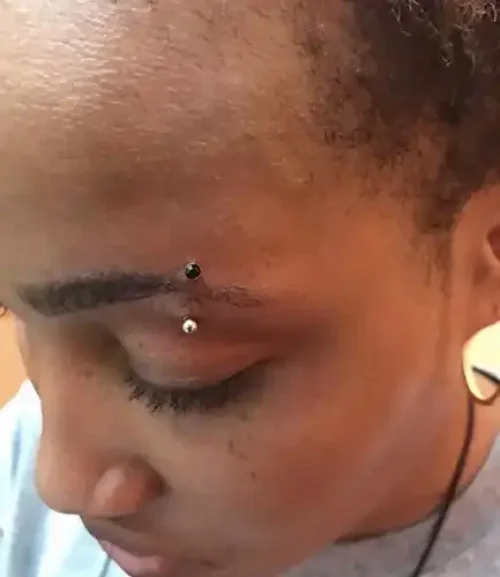Eyebrow Piercing in Nairobi, Kenya
An eyebrow piercing is a type of facial piercing where a small piece of jewelry, usually a barbell or ring, is inserted through the skin above the eyebrow. It’s a popular piercing choice for its unique aesthetic and expressive look, offering a bold way to enhance facial features.
Eyebrow piercings have become increasingly popular in contemporary body art, often chosen for the way they emphasize expression and individual style. Is there a particular focus you’d like for this, such as historical context, aftercare details, or style options?
Eye-brow Piercing
Key Aspects of Eyebrow Piercing:
- Location: It’s generally done vertically through the eyebrow, typically near the outer edges but can also vary depending on individual preference and anatomy.
- Jewelry: Common jewelry options include curved barbells, which are often chosen for their lower risk of rejection, or captive bead rings for a bolder look.
- Healing Process: Eyebrow piercings take about 6-8 weeks for the initial healing, but full healing can take several months. Aftercare is essential to prevent infections and promote smooth healing.
Eyebrow Piercing Styles
- Vertical Eyebrow Piercing: The most traditional, placed vertically above the brow.
- Horizontal Eyebrow Piercing: Sits horizontally across the eyebrow for a unique look.
- Anti-Eyebrow Piercing: Positioned just below the eye, sometimes called a “teardrop” piercing, creating an edgier appearance.
- Multiple eyebrow piercings consist of more than one piercing. The most common type of piercing is a double piercing, however, some people have even had their entire eyebrows pierced. To make the healing process easier if you go with this option, only get one piercing at once.
Eye-brow Piercing Procedure
The eyebrow piercing procedure should always be performed by a professional piercer in a clean and sterile environment. Here’s a general outline of the steps involved in the eyebrow piercing procedure:
- Consultation: Before the procedure, you’ll have a consultation with our piercer. During this discussion, you can ask questions, discuss your expectations, and choose the jewelry type and size. Our piercer will also assess your eyebrow’s natural shape and discuss placement options.
- Preparation: Our piercer will sterilize their hands and wear disposable gloves to ensure aseptic conditions. They’ll also disinfect the area around your eyebrow where the piercing will be done.
- Marking: Our piercer will use a surgical marker to mark the exact placement of the eyebrow piercing. Achieving symmetry is crucial, so you and our piercer will check the markings in a mirror to ensure you’re satisfied with the placement.
- Piercing: Using a sterilized needle, our piercer will create the hole for the piercing. Our piercer may use clamps to hold the skin in place and minimize movement during the procedure. This helps ensure precise and accurate piercing.
- Jewelry Insertion: Once the piercing hole is created, our piercer will insert the chosen jewelry, which is typically a straight or curved barbell. The jewelry will be secured in place, and any necessary adjustments will be made to ensure it sits comfortably.
- Aftercare Instructions: After the procedure, our piercer will provide you with detailed aftercare instructions. These instructions typically include cleaning the piercing with saline solution, avoiding touching the jewelry with dirty hands, and refraining from applying makeup or skincare products to the area during healing.
- Healing Process: Eyebrow piercings can take several weeks to a few months to heal fully. During this time, it’s crucial to follow the aftercare instructions diligently to minimize the risk of complications and promote proper healing.
- Follow-up Appointments: Our piercer may schedule follow-up appointments to monitor the healing process and make any necessary adjustments to the jewelry. They can also address any concerns or issues that may arise during the healing period.
- Pain and Discomfort: It’s normal to experience some pain, swelling, and discomfort during and after the procedure. Over-the-counter pain relievers can help manage the pain, but always follow your piercer’s recommendations.
- Risks and Complications: Be aware of potential risks, including infection, swelling, migration, scarring, and jewelry rejection. Report any signs of infection, such as excessive redness, discharge, or severe pain, to your piercer or a healthcare professional promptly.
- Lifestyle Considerations: Keep in mind that some lifestyle activities, such as swimming or contact sports, may need to be avoided during the healing process to prevent irritation or infection of the piercing.
Considerations before getting a Eye-brow Piercing
Before getting an eyebrow piercing, it’s essential to carefully consider several factors to ensure that it’s the right choice for you and to prepare for the piercing procedure and aftercare properly. Here are some key considerations:
- Professional Piercer: Choose a reputable and experienced professional piercer who is licensed and follows strict hygiene and safety practices. Research and read reviews to find a piercer with a good reputation. At Rebel Inks Tattoo Removal and Piercings Parlour we have extensive experience and experienced team that is geared to offer you the best services Contact Us Today for further consultation and scheduling
- Placement: Discuss the placement of your eyebrow piercing with your piercer. Placement can vary from person to person based on personal preference and facial anatomy. The piercer can help you choose the best placement to complement your facial features.
- Pain Tolerance: Consider your pain tolerance level. Eyebrow piercings can be painful during and immediately after the procedure, but the pain is usually short-lived. If you have a low pain tolerance, discuss pain management options with your piercer.
- Jewelry Type: Discuss your jewelry options with your piercer. Straight or curved barbells are common choices for eyebrow piercings. You can also choose from various materials like surgical steel, titanium, or niobium. Consider any metal allergies or sensitivities you may have when selecting jewelry.
- Healing Time: Be prepared for the healing process. Eyebrow piercings can take several weeks to a few months to fully heal. During this time, you’ll need to follow a strict aftercare routine to prevent infection and promote proper healing.
- Risks and Complications: Understand the potential risks associated with eyebrow piercings, including infection, swelling, migration, scarring, and jewelry rejection. Knowing these risks and following aftercare instructions can help minimize complications.
- Personal Style: Think about how an eyebrow piercing will fit into your personal style. It can be a unique and edgy addition to your appearance, but it’s essential to ensure it complements your overall look.
- Work and Lifestyle: Consider your job, daily activities, and lifestyle. Some employers may have policies against visible facial piercings, so evaluate the impact on your work. Also, consider activities that may interfere with the healing process, such as swimming or contact sports.
- Aftercare Commitment: Understand that proper aftercare is crucial for a successful eyebrow piercing. Be prepared to clean the piercing with saline solution, avoid touching it with dirty hands, and refrain from makeup or skincare products that could irritate the piercing during the healing period.
- Future Plans: Think about your future plans, such as potential job changes or lifestyle adjustments. While eyebrow piercings can be removed if necessary, they may leave scars. Consider the long-term implications.
- Consultation: Have a thorough consultation with your piercer before the procedure. Discuss your expectations, desired look, and any concerns. A professional piercer can assess whether you are a suitable candidate for an eyebrow piercing and provide personalized advice.
Pain and Healing for a Eyebrow Piercing
When it comes to eyebrow piercing pain and healing, here’s what you and your clients should know for a smooth, comfortable experience.
Pain Level
- Pain Scale: Eyebrow piercings are generally rated as moderate on the pain scale. The eyebrow area has thin skin with some nerve endings, but it’s not considered as painful as areas with denser tissue, like cartilage.
- What to Expect: Clients may feel a quick, sharp pinch during the procedure, followed by minor throbbing or soreness in the first few days.
- Factors Affecting Pain: Pain tolerance varies between individuals, but using a skilled, experienced piercer and a quality needle helps reduce discomfort.
Healing Process
- Healing Time: The average initial healing period for an eyebrow piercing is 6-8 weeks, but full healing can take 3-4 months.
- Stages of Healing:
– Inflammation (Days 1-3): The area may be swollen, red, and tender.
– Granulation (Weeks 1-4): A crust may form around the jewelry, which is normal and should be gently cleaned.
– Maturation (Weeks 4-8): The piercing gradually settles, and swelling decreases as the tissue begins to strengthen.
Reducing Pain and Complications
- Avoid Changing Jewelry Early: Changing jewelry too soon can disrupt healing.
- Opt for Light Jewelry: Curved barbells are ideal because they put less pressure on the skin, which can reduce the risk of migration or rejection.
Eyebrow Piercing Aftercare
Proper aftercare is essential for a healthy, healed eyebrow piercing. Here’s a comprehensive guide to help your clients keep their eyebrow piercings clean, infection-free, and looking great!
Eyebrow Piercing Aftercare Tips
- Clean Twice Daily with Saline Solution
– Use a sterile saline solution or a piercing aftercare spray to clean the area twice a day.
– Apply the solution with a clean cotton pad, letting it soak gently on the piercing site. Avoid using alcohol or hydrogen peroxide, as these can be too harsh and delay healing. - Avoid Touching or Twisting the Jewelry
– Hands carry bacteria, which can increase the risk of infection. Unless you’re cleaning it, avoid touching or twisting the jewelry.
– Turning or twisting the jewelry can damage healing tissue and lead to irritation or prolonged healing time. - Keep Makeup and Hair Products Away
– Avoid applying makeup, lotions, or hair products near the piercing. These can introduce bacteria or clog the healing area.
– When washing your face or applying skincare, be extra gentle around the piercing. - Sleep with Care
– Avoid sleeping on the side with the piercing for the first few weeks. This helps prevent unnecessary pressure and irritation.
– Consider sleeping on your back or the opposite side to minimize contact with the piercing. - Avoid Pools and Hot Tubs: Pools, hot tubs, and natural bodies of water can contain bacteria that may lead to infections. Try to avoid these until your piercing is fully healed.
- Watch for Signs of Infection
– Redness, swelling, or unusual discharge (especially yellow or green) can be signs of infection. If you experience any of these symptoms, it’s best to consult a professional piercer or healthcare provider.
– Mild soreness is normal in the first few days, but persistent pain or a warm sensation around the piercing area could also indicate infection. - Maintain a Healthy Lifestyle: A healthy immune system supports faster healing. Stay hydrated, eat a balanced diet, and avoid excessive stress to support your body’s natural healing processes.
- Avoid Changing Jewelry Early: Keep the initial jewelry in place for the full healing period, usually 3-4 months. Changing jewelry too soon can interfere with healing and cause complications.
Common Do’s and Don’ts
- Do: Be patient and gentle with the piercing to allow it to heal smoothly.
- Don’t: Apply ointments, as they can trap bacteria and irritate the piercing.
Proper aftercare can make all the difference in a smooth healing process!
Eyebrow Piercing Jewelry
When it comes to eyebrow piercing jewelry, there are several options that suit different styles and preferences. Here’s a guide to help clients choose the right type of jewelry for their eyebrow piercing:
Types of Eyebrow Piercing Jewelry
- Curved Barbells
– Description: The most popular choice for eyebrow piercings, with a gentle curve that follows the natural line of the brow.
– Pros: Reduces pressure on the piercing, helping minimize the risk of rejection or migration.
– Material Options: Surgical steel, titanium (hypoallergenic), and gold.
– Ideal For: Those who want a low-profile, comfortable look. - Captive Bead Rings (CBRs)
– Description: A circular ring with a small bead that keeps it in place.
– Pros: Adds a bold look and is easy to clean; versatile for those who want to change styles after healing.
– Material Options: Typically available in surgical steel, titanium, and occasionally in niobium.
– Ideal For: Clients who prefer a round, statement look. - Horizontal Barbells
– Description: Used for horizontal eyebrow piercings that run parallel to the eyebrow.
– Pros: Unique and eye-catching, great for those looking for an unconventional style.
– Material Options: Often available in titanium and surgical steel.
– Ideal For: More advanced piercings; recommended only for healed piercings or those comfortable with a second piercing. - Straight Barbells
– Description: A straight bar with threaded balls on each end.
– Pros: A minimalist option, although less common due to slightly higher migration risk in eyebrow placements.
– Material Options: Available in surgical steel and titanium.
– Ideal For: People who prefer a simple, understated look. - Microdermal and Surface Anchors (for anti-eyebrow or “teardrop” piercings)
– Description: Surface anchors are implanted under the skin, while microdermals use a single-point anchor.
– Pros: Creates a subtle, jewel-like appearance; doesn’t require a ring or barbell.
– Material Options: Often titanium due to its biocompatibility.
– Ideal For: Advanced styles below the eyebrow or as a standalone statement.
Choosing the Right Jewelry Material
- Titanium: Hypoallergenic and lightweight, making it perfect for sensitive skin.
- Surgical Steel: Affordable and durable, though it contains trace amounts of nickel, so it’s not recommended for those with metal sensitivities.
- Gold: Solid gold (14k or 18k) is great for healed piercings; avoid gold-plated options as they may irritate.
Jewelry Sizing and Gauge
- Gauge: Most eyebrow piercings use a 16 or 18 gauge (1.2mm – 1.0mm). Smaller gauges are thinner and may migrate more easily.
- Length/Diameter: Curved barbells are generally 8mm to 10mm in length, though this can vary based on the client’s anatomy.
At Rebel Inks Tattoos, Tattoo Removal, and Body Piercings Parlour we offer clients a range of options tailored to their style, comfort, and skin sensitivity enhancing their overall experience and satisfaction.
Eye-brow Piercing FAQ’s
Cost of a Eyebrow Piercing in Nairobi, Kenya
The cost of an eyebrow piercing varies depending on the studio’s location, reputation, and the type of jewelry chosen. Here’s a breakdown of typical pricing and what factors can influence the overall cost:
Average Cost Range
- Typical Cost: Eyebrow piercings generally range from Ksh. 1,500 to Ksh. 2,500 for the piercing alone.
- Jewelry Cost: Basic jewelry is often included, but if clients choose premium options, like titanium or gold, it may add an additional Ksh. 1,000 to Ksh. 3,000
Eye-brow Piercing Price Breakdown Table
Cost Component | Estimated Cost (KSh) | Details / Notes |
Basic eyebrow piercing (procedure) | 1,500 – 2,500 | Cost range at Rebel Inks for standard eyebrow piercing |
Premium jewelry upgrade | 1,000 – 3,000 | Titanium, gold, hypoallergenic or decorative pieces |
Aftercare products (e.g. saline) | 500 – 1,000 | Sold at studio if not included in package |
Estimated Total (basic package) | 1,500 – 2,500 | Procedure (and possibly basic jewelry at some studios) |
Estimated Total (all-inclusive) | 3,000 – 6,500 | Procedure + premium jewelry + aftercare supplies |
Factors Affecting Price
- Studio Reputation: High-end studios with experienced piercers and a strong reputation may charge more due to expertise and quality. At Rebel Inks Tattoos, Tattoo Removal, and Body Piercings Parlour we have a team of experienced and professional body piercers that will offer quality eye-brow piercing.
- Jewelry Material: Standard surgical steel is typically less expensive, while titanium, gold, and hypoallergenic options increase the cost.
- Location: In major cities, eyebrow piercings are often pricier than in smaller towns. Rebel Inks Tattoos, Tattoo Removal, and Body Piercings Parlour is located in the heart of the Central Business Disrict (CBD) in Nairobi, Kenya, and is easily accessible to both locals and foreigners in the country.
Other Potential Costs
- Aftercare Products: Saline solution or aftercare sprays can cost around Ksh. 500 to Ksh. 1,000 if purchased at our studio.
Possible side effects of Eyebrow Piercing
Like any body piercing, eyebrow piercings come with potential side effects, though most are mild and temporary. Understanding these risks helps clients make informed decisions and care for their piercings properly.
Possible Side Effects of Eyebrow Piercing
- Swelling and Redness
– Cause: Normal healing process, especially in the first few days after piercing.
– When It Happens: Swelling can occur immediately after the piercing or within the first few days as the body responds to the foreign object.
– Solution: Mild swelling is usually temporary. Use ice packs (wrapped in a cloth) for short periods to reduce swelling. - Tenderness and Discomfort
– Cause: The body adjusting to the piercing and the trauma caused by the needle.
– When It Happens: Some tenderness is normal during the first few days to a week.
– Solution: Pain relief medications (like ibuprofen) can help manage discomfort. Avoid touching or twisting the jewelry. - Infection
– Cause: Bacterial introduction due to poor aftercare or touching the piercing with unclean hands.
– Signs: Increased pain, redness, warmth, pus (yellow or green), or a foul odor.
– Solution: If an infection is suspected, clean the piercing with saline solution, and seek medical attention. Infections may require antibiotics or removal of the jewelry in some cases. - Migration and Rejection
– Cause: The body pushing out the jewelry, which can happen with improper placement, trauma, or irritation.
– Signs: The piercing begins to shift or the jewelry becomes loose.
– Solution: Choose a professional piercer with experience to ensure proper placement. If rejection occurs, removal of the jewelry may be necessary to avoid further irritation. - Scarring or Keloids
– Cause: Excessive scarring during the healing process, often due to infection, irritation, or improper aftercare.
– Signs: Raised, thickened, or discolored tissue around the piercing site.
– Solution: Proper aftercare reduces the risk of scarring. If keloids form, consult a healthcare provider for treatment options. - Allergic Reaction to Jewelry
– Cause: Sensitivity or allergy to metals like nickel, which is sometimes found in lower-quality jewelry.
– Signs: Redness, swelling, or itching around the piercing.
– Solution: Opt for hypoallergenic jewelry made of titanium, niobium, or high-quality gold to avoid allergic reactions. - Excessive Crusting or Discharge
– Cause: The body’s natural healing process can produce crusty buildup around the jewelry, which is normal.
– Signs: A small amount of clear or whitish discharge is normal, but excessive crusting could indicate improper cleaning.
– Solution: Gently clean the area with saline solution to prevent crust buildup. - Bleeding
– Cause: Piercing through blood vessels in the eyebrow area.
– When It Happens: Minor bleeding during the piercing procedure is typical, but should stop immediately after.
– Solution: If bleeding continues or seems excessive, contact our piercer immediately.
Tips for Preventing Side Effects:
- Follow Aftercare Instructions: Clean the piercing with saline solution, avoid harsh chemicals, and never twist the jewelry.
- Avoid Sleeping on the Piercing: Sleeping on the side of the piercing can cause unnecessary irritation or pressure.
- Don’t Change Jewelry Too Soon: Wait for the full healing period before changing jewelry to avoid complications.
Related Piercings
Surface Piercings →
Get In Touch
For more information on the list above and any other special services,please call or come in for free consultation
Testimonials
After he pierced my industrial piercing and seeing his amazing work, I feel even more excited about getting my tattoo with him in January. I’m really looking forward to it!
I am extremely happy with my new 'Safari' tattoo from Eric at Rebel Inks! The quality of the artwork is fantastic. Eric is a true professional and an amazing artist.
The preparation and design process was thorough and collaborative. He was very patient with my specific requests, including making sure all the elements, which hold personal meaning, were perfect.
The service was friendly and highly professional from start to finish. Despite the 8-hour session, Eric was a pleasant person to spend the time with.
The aftercare guidance and follow-up have been excellent and careful, which has made the healing process easy and better than expected.
I highly recommend Eric for anyone looking for a thoughtful, talented, and caring tattoo artist.
I recommend them 💯
I would definitely recommend if you’re thinking of getting a piercing!
The staff were super friendly, explained everything clearly, and made me feel so at ease. They answered all my nervous questions (and I had many questions),
They walked me through the whole process, gave detailed aftercare instructions, and even followed up afterward to check how I was healing 🫶
Clean, professional, and full of good vibes.
Would 100% recommend . Definitely making a second trip here.
This was the second tattoo I got and I wish I could have come to Eric for my first one! He gave me really great after-care directions for the tattoo as well as a little jar of his own Vaseline-type stuff to put over my tattoo while it was healing! He even put second skin over my tattoo so that I didn’t have to worry about it for the first few days. Now THAT’S good service. My first tattoo artist didn’t do none of that lol.
After the session Eric didn’t rush me and my friend out, he chatted with us and even when he found out I was an artist too— really encouraged me to keep creating and to find a community of artists to support me. I almost cried because I’ve had such a hard time with my own art the past couple of years, it meant so much to me to have a fellow very talented artist say that to me. 🤍🤍🤍
Eric you’re amazing, don’t ever stop creating and just know you’ve impacted lives all over the world!🫶🏻 thanks so much for everything!!
From the moment I walked in, Eric was professional, welcoming, and attentive. He made sure I was comfortable throughout, provided everything I needed, and explained every step of the process. The tattooing itself was unbelievably smooth - I genuinely felt no pain compared to my previous tattoos over the last 22 years.
Eric also gave me excellent aftercare guidance and products, and thanks to that, my tattoo healed beautifully. The attention to detail, precision, and shading are absolutely stunning. This is hands-down the best tattoo I've ever had, and I will be flying back to Nairobi for any future ink.
If you want incredible art, a professional experience, and a talented artist who truly cares about his clients, Rebel Ink is the place to go!
From start to finish, the service was exceptional. The piercer was professional, knowledgeable, and made me feel completely comfortable. The cleanliness of the place was above and beyond — everything was spotless and hygienic, which really put me at ease. Highly recommend for anyone considering a piercing!
Shout out to Eric😘
We ended up changing the jewelry three times to ensure I had the best fit and avoided any signs of rejection, and he always listened to my suggestions as a client, which I really appreciated. Now, three months in, my piercing is healing beautifully, with no sign of rejection. Highly recommend for anyone who values a piercer who cares about your comfort and healing journey!
What stood out the most was the aftercare Eric checked in with me even three weeks later to see how the tattoo was healing. That kind of follow-up shows how much he truly cares about his work and his clients.
I’m very satisfied and will definitely be coming back for my next piece. Highly recommend!
The piercing wasn't as painful as I had thought and the process was quick and satisfactory. I love it!!!
The piercing is healing well thanks to the aftercare instructions and follow-up. I would highly recommend Rebel Inks
Eric also did a belly button piercing for a friend, guiding her through the process, doing the piercing and then explaining the after care to her.
The shop is on the 3rd floor, with the entrance to the stairs near an alleyway on the left. The shop is perfect size, clean, and attractive looking. The mural is pretty dope.
Thank you for the amazing service! 🔥👅✨
I got piercibgs there and the process was really good. My biggest concern was hygiene but that wasn't an issue at all, they use new needles and they sanitize them.
The service itself was also welcoming.
I was informes of everything i needed to know beforehand.
10/10 would recommend!
Eric was so calm and patient with my almost 2 year old lady. It was such a clean and hygienic process. We will definitely be back for our second rounds of piercings and maybe even another tattoo!
They assess the area before any art and advise one accordingly. They also give one post clean up process and also do a check up after the body art projects. Overall, I loved my experience and I’m hooked. 👍
Will definitely come back next time I’m in town 🙂
He listened to what I actually wanted and made sure he could fit in the time before I flew back home.
The shop is clean & private and is easy enough to find.
Eric has even checked in a couple of times since to make sure all is good.
I would totally recommend Eric! I absolutely love my Elephants!
I had a very easy healing period and always follow up from Eric to check on my progress...I would highly recommend if you are a first timer because from my experience all went very well and attention to detail
Thank you for a good job and looking forward to send all my friends your way
And all the best with the new year 2025!
From the moment I walked in, the staff was super friendly and made me feel at ease. The studio had a clean, professional atmosphere, which immediately put me at ease. My piercer was incredibly skilled and explained every step of the process, ensuring I was comfortable the entire time. The piercing was quick and practically painless, and the aftercare instructions were clear and easy to follow. I can tell they really care about the health and safety of their clients.
Overall, a fantastic experience—I highly recommend Rebel Inks and Tattoos for anyone looking to get pierced or tattooed!
They do follow up after their services
Eric's Studio isn’t just a place to get a tattoo—it’s an experience. The combination of professionalism, artistic talent, and a welcoming environment makes it a standout destination for anyone considering a tattoo.
I highly recommend Eric’s Studio to both first-timers and seasoned tattoo enthusiasts. If you’re looking for a high-quality tattoo and an enjoyable experience, this is the place to go.
I would definitely recommend their services again and again
Thank you Rebel Ink
My piercings are healing ❤️🩹 well
I would 💯 recommend
I will definitely come back for more .
Two, all the equipments he used for the piercings were new and/or sterilised.
Three, the parlour itself was very clean and was up to par with the hygiene standards.
Four, Eric provided effective aftercare instructions, making sure I knew exactly how to take care of my new piercings and he kept in touch and continues to do so, to check on the healing progress.
I highly highly highly recommend this place!!!
Would definitely recommend them to friends and go back for other piercings
Not only was the piercing process smooth, but he also provided thorough aftercare instructions, making sure I knew exactly how to take care of my new piercings. What really impressed me was that he keeps in touch to check on how the healing is progressing – a sign of true care for his clients.
The shop maintains a high standard of hygiene, and the atmosphere is welcoming and comfortable, which really added to the positive experience. I highly recommend this place to anyone looking for a professional and caring experience. I’ll definitely be coming back for any future piercings!
My appreciation for the excellent customer service I received. The follow-ups were prompt, and I truly appreciated the gentleness and professionalism throughout. Thank you!"
"Looking for professional eyebrow microshading removal? Look no further!"
The customer care is top tier 👌🏾👌🏾.
Wonderful place to get tattoos and piercings. 💯💯
Eric goes ahead to follow up on his clients progress and gives good advice each time I reach out to him.
I would recommend Reble tattoos anytime.
Good job bro we really appreciate.
Ohh and the price is very fair.
The environment was clean , procedure was sterile and the jewelry used are of the best quality.
He followed up with me during the healing process, he educated me on what I needed to do for my aftercare.
Eric is confident, skilled , experienced and the best piercer. Highly recommend Rebel inks.✨
Definitely recommend!
Great experience.
Eric definitely know what he is doing .
I got exactly what I wanted 2 tiny tats on the same finger .
He was kind and patient throughout the session.
Healing process has been good .
Aftercare services were given and regular checkups on the healing process were done.
I would 💯recommend.
Eric gave me the best reception as it was my first time there,and made me trust him all the way. I appreciate good services.
There services are also affordable not to forget 😊.
He was also invested in the aftercare and would ensure I follow the do's and don'ts in taking care of the tattoo and ensuring proper healing and maximum ink retention.
Would highly recommend Rebel Inks Tattoos.
Rebel Inks Tattoo offer the best,affordable and quality tattoo removal services.If you have unwanted ink,choose Rebel Inks Tattoo,they're the best of the best and the professionalism is a top notch.They ensure you're free from unwanted ink with their Laser Tattoo Removal Technology...
I did a Laser Tattoo Removal with them and i can attest they're the best....
Kudos Eric...
I highly recommend.
It was a generally good experience with good hygiene during the piercing process and has been a smooth healing process.... 10/10
tips. Highly recommend 👍🏽
100% recommendable.
I was particularly impressed with Eric's attention to hygiene. He thoroughly cleaned the room before I entered, sanitized all of the equipment he would be using, and changed gloves between each ear. This level of cleanliness gave me great confidence in his professionalism.
Eric's commitment to customer service did not end on the day of the piercing. He followed up with me regularly throughout the healing process to ensure that I was following the aftercare instructions and that my earlobes were healing properly.
I highly recommend Rebel Inks to anyone in Nairobi who is considering getting a piercing. Eric is a highly skilled and experienced piercer who takes great pride in his work.
So I Check all the boxes below and more:
Customer Care: ✔️
Professionalism : ✔️
Cleanliness ✔️
Price: ✔️
After care service ✔️
Thanks and good job, Eric
The place is neat and clean and the equipments he used were also fine standards. Really appreciate his following up with me on the healing 🤗
I WOULD HIGHLY RECOMMEND THEIR SERVICES to everyone. Actually what you see on their website is EXACTLY what you will get. Keep up the good work Rebel inks Tattoos.
The infection is now gone. I would definitely recommend!
Can recommend this place totally and would go back there anytime!
Thanks!
OUR LOCATION
Areas We Serve
NAIROBI
KIAMBU
KAJIADO
MACHAKOS
















































































































































































































